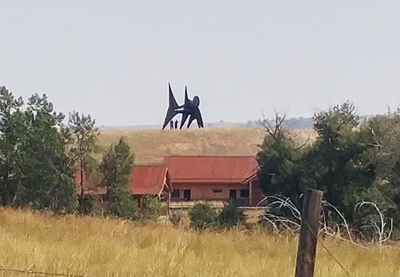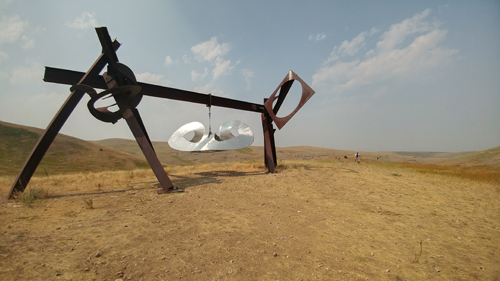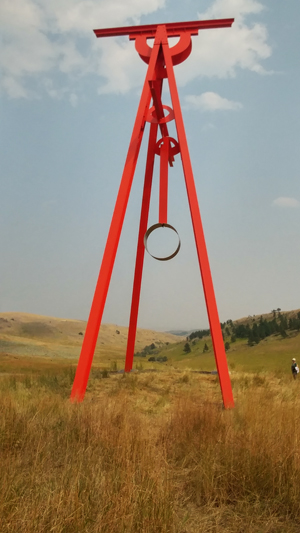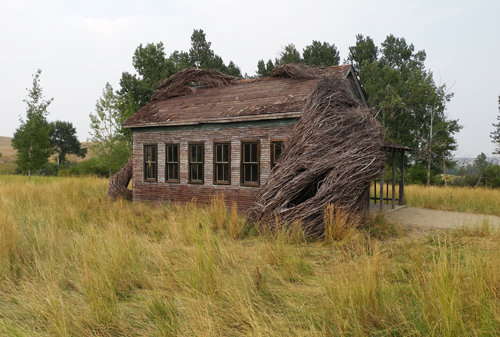Art Review: Tippet Rise Arts Center -
Encountering Art, Music, and Technology in Nature
Text and Photographs by Mark Laiosa
arttimesjournal September 25, 2018
Spread over and around the foothills of the Beartooth Mountains near Fishtail, Montana is an ambitious ongoing development of creative activity. The Tippet Rise Art Center conceived by artists Cathy and Peter Halstead melds sculpture, music, and nature within an active cattle and sheep ranch spread over more than 10,000 acres.
 Alexander Calder “Two Discs” |
Fishtail Montana isn’t bookmarked on many people’s devices, about equidistant from Billings and Bozeman. It is a big draw for locals and international visitors touring Yellowstone. Reservation time is posted on the website and filled within minutes. Time magazine has Tippet Rise listed as one of the world’s greatest 100 places to visit in 2018. The season runs Friday, Saturday, and Sundays, 10 AM to 3 PM, from June through September. The name comes from Cathy’s nickname for her mother, Tippet, as well as twine for tying a lure to a fishing line. Rise refers to a sheep’s spring growth of wool, and the flat top “benches” of land where Tippet Rise sits. The logo is an outline from one of Cathy’s stone paintings. The Center is working on earning a platinum LEED certification for the Olivier Music Barn using geothermal, hydrologic, and gray water systems. A solar canopy powers part of the infrastructure and the electric touring vans.
Before visiting guests need to register at the front gate and then park in a large lot, out of sight. In keeping with the harmony of open spaces; rest rooms are designed as stacks of wood and blend in with the rustic nature of the countryside. There is additional parking outside of the Olivier Music Barn.
 Mark di Survero “Beethoven's Quartet” |
The high ceiling rectangular barn has a grilled picture window framing the Beartooth Mountains. This is the backdrop for the performing artists. The larch wood interior projects a warm bright sound that is captured by the state-of-the-art, sound and video recording system with the capability to live stream performances online. Co-curators Wu Han and David Finckel have crafted a series of chamber music programs that draw upon the large selection of Steinway pianos available for the artists. The Barn is the welcome center processing tour van reservations, concert ticket sales ($10, under 21 free), the gift shop, art and music related books, performing artists CDs, and Tippet Rise caps and metal water flasks.
Will’s Shed, steps away from the Music Barn, serves food and spirits, convenient for pre and post gatherings.
 Mark di Suvero “Proverb” |
Not far from the Music Barn is the Tiara, designed by Alban Bassuet and Willem Boning of Arup in response to Peter Halstead’s design to put a surplus of doors to musical work. The result is a wall-less, roof-less horse shoe acoustical shell that seats approximately 100 people. The panels above the line of sight reflect music into the space while giving concert goers an unobstructed view of the surrounding hills.
Sculptures are sited on the 10,000 plus acreage and can be toured by foot, with your bicycle (helmets required), or via electric van, taking approximately 2.5 hours and cost $10 per person; under 21 it’s free. The quiet vans take you close to the sculptures, where you can exit and enjoy the different perspectives, or stay and linger, getting onto another van. Fields of gold, stray cactus or black angus are the backdrop for many sculptures; a whiff of prairie sage, and silence adds to a sense of place.
Sited on an alluvial bench overlooking the Olivier Music barn is Calder’s Two Discs (1965) on loan from the Hirshhorn Museum and Sculpture Garden in Washington, DC., and visible from many areas.
Two Mark di Suvero’s works have space to breathe. Beethoven’s Quartet (2003), sited on another rise invites the viewer to pick up rubber mallets and strike the sculpture. The hanging mobius resonates and sound spreads over the area. A little further on, jutting out from a small rise in a descending coulee, is the 70-foot-tall Proverb (2002); scale of the surrounding hills brings the eyes to focus on this bright red work. Quite a different context from its earlier installation in Dallas’ art district, across from the Meyerson Symphony Center (the space now an office building).
 Patrick Daugherty “Daydreams” (exterior) |
Patrick Dougherty’s Daydreams (2015), pairs a full-size frontier styled school house with woven sticks and willow saplings growing around and through the building. Once inside the school house the willows have a powerful aroma, Messages are scrawled across the single room’s chalkboard. The sensuous weave of willow is a contrast with the right angles of the chalkboard and room.
Three sculptural structures by Ensamble Studio (Antón Garcia-Abril and Débora Mesa, Spain) use an excavation and repacking as the shaping source. Backfilled in with a mixture of soil, concrete and reinforcing rods, to create three works, Inverted Portal, Beartooth Portal, and Domo, doubles as another outside performance venue. The graceful curving arches offer shade and acoustics that throws sound beyond the sculpture.
Stephen Talasnik’s Satellite No. 5 Pioneer (50’ x 45’ x 35’) is a syncopated pattern of yellow cedar shafts and corten steel corralled by longer shafts that sit in a natural amphitheater. New Yorkers might have seen his 115-foot installation of lashed bamboo, Streams (2009-11) at Storm King Arts Center. Here the Pioneer rests as if on an alien landscape. Mr. Talasnik will be creating additional works for Tippet Rise.
Part of the ongoing development at Tippet Rise is a commission for Francis Kéré of Kéré Architecture (Germany), and winner of the Aga Khan Award for Architecture to create an unnamed pavilion. It’s a circular wooden walkway over a creek, shaded by cottonwood and aspens and leads to a small wooden pavilion roofed by short pieces of tree trunks, scheduled to open during summer 2019.
When you go, charge your camera/phone, pack water, sun screen, allergy medications and keep an eye out for ticks. No dogs or pets permitted. Have fun!
For more information and reservations visit, www.tippetrise.org
